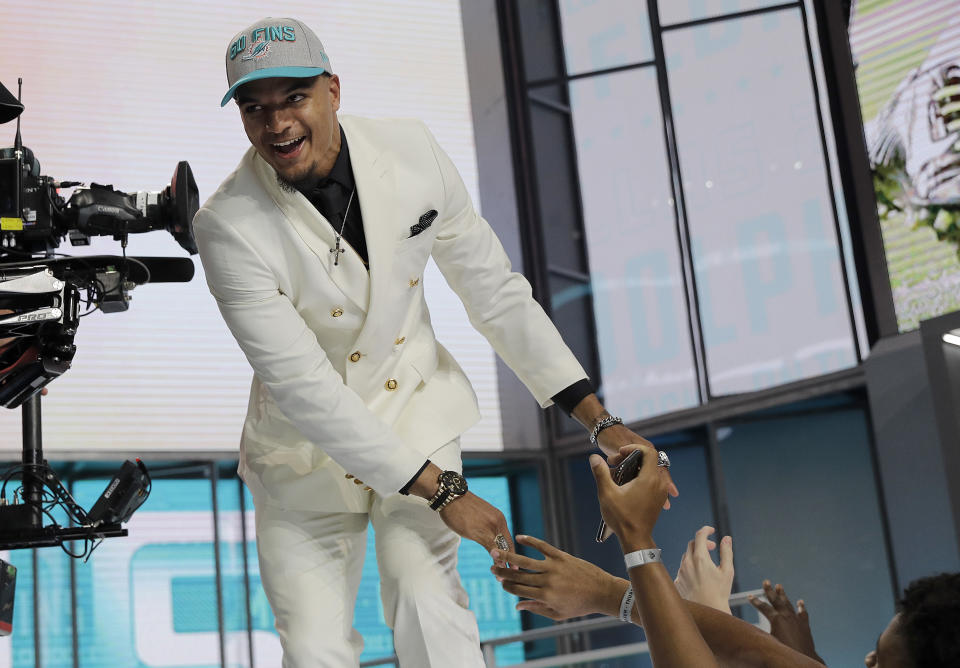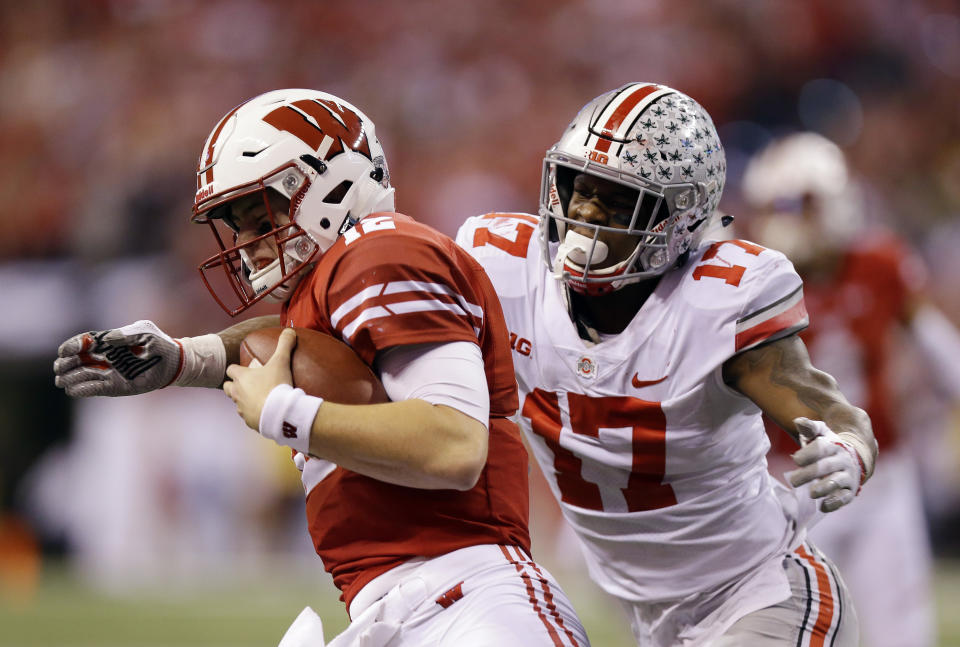Secret life of NFL scouts: The calm of Dolphins draft night
Editor’s note: Yahoo Sports reporter Pete Thamel spent nearly a year entrenched with NFL scouts in preparation for the 2018 draft. This is the 10th story of a 10-part series.
Secret life of NFL scouts
• Part 1: How the Dolphins’ draft came together
• Part 2: How GM, coaches work together in picking players
• Part 3: Examining the player and the person
• Part 4: What scouts look for at practices
• Part 5: ‘We don’t want a team of exceptions’
• Part 6: Why ‘workout wonders’ can become draft busts
• Part 7: One grunt keeps tabs on all players, schools
• Part 8: Memorable ‘Olympic marathon’ debate over Jordy Nelson
• Part 9: Why scouts love visiting Nick Saban and Alabama
• Part 10: The calm of Miami Dolphins draft night
• Breaking down the 8 players Miami drafted
DAVIE, Fla. – On a wall in the windowless Miami Dolphins draft room, there’s a quote from former USA hockey coach Herb Brooks. A few feet from the novelty faux WWE belt that implores the Dolphins to “Scout Like a Champion” is Brooks’ famous line about team building: “I’m not looking for the best ones. I’m looking for the RIGHT ONES.”
Over three days in the Dolphins facility, the quest to find both plays out. For the scouts who’ve traversed the country, written nearly 4,000 reports and done endless background calls, the actual draft is a bit anti-climactic. Surely, there’s nerves and excitement inherent to the build-up to a moment they’ve poured so much into.
But one of the scout secrets of draft week is that it’s actually one of their slower weeks of the year. The big decisions – Who to pick? Should they trade? – are made up the food chain. The scouts are around and available to assist, but it’s a much less hectic time than the traditional five cities in four nights slog through college towns they’re accustomed to from August through November.

Director of college scouting Adam Engroff assembled a staff bowling outing the night before the draft. A few scouts squeezed in nine holes during the morning of the days when the draft began in prime time. Their work is long done, as the scouts’ volumes of research had been dissected throughout the February meetings, refined earlier in April and accumulated on the 20-yard-long wall in the Dolphin draft room.
The first night of the draft is a formal affair in the Dolphins facility, as everyone dons suits and ties for the token war room shot on television.
The hours before the Cleveland Browns select No. 1 are a more informal chess match, as national scout Matt Winston stands in one of the building’s Information Technology offices standing across from Rao Bandarupalli, the franchise’s business intelligence architect, looking at an actual chess board. Aside the chess board, there’s a white sheet of paper that says “Scouts Turn” on one side and “IT Turn” on the other, as the on-going game encompasses multiple members and often takes months.
Spending three days in the Dolphins’ facility offers a reminder that an NFL office isn’t all that different than a conventional American office. There’s small talk in the breakroom about free food and good-natured ribbing all around. Coach Adam Gase gave one of the Dolphins’ young scouts, 32-year-old Chase Leshin, a list of movies he missed because he’s so young that are detailed on a whiteboard in his office. (“Fletch” was checked high off the list). Even Dan Marino, who serves as a special adviser for the franchise, isn’t immune to office ribbing. There’s a picture taped outside Marino’s office of him wearing orange and aqua Zubaz pants in his early 1990s prime.
[Yahoo Fantasy Football leagues are open: Sign up now for free]
Eventually, the real action shifts to the draft room, which is secured and requires a punch code to enter. The draft board is hidden behind a floor-to-ceiling black curtain when the doors are open. The four scouts not in the draft room watch on television in a bullpen cubicle across the hall, with the NFL Network chosen because that’s what happened to be on.
After picking Minkah Fitzpatrick with the No. 11 pick in the first round, the final two days and seven additional picks show how all those reports, miles and insights mesh together.
When the Dolphins’ pick comes up in Round 2, Northeast scout J.P. McGowan gets called into the room by the brass. McGowan, 29, scouts the region and does cross-checks on the tight ends. His trip to the room signaled Miami’s affinity for tight end Mike Gesicki. (It ended up being a busy night for McGowan, as Miami added tight end Durham Smythe in Round 4).
The Gesicki pick also called to mind a running joke that evolved throughout this project, as the scouts resolutely avoided taking credit for players. This “Dolphin Deference,” as it became known, was epitomized when Winston went out of his way after an interview to be sure adequate credit was given to other scouts regarding an undrafted free agent named Cam Malveaux, a defensive lineman from the University of Houston.
The hesitation for a scout to receive credit for a player became more obvious in real time, as so many different people – executives, coaches, analytics, security and medical – inspect and project prospects that crediting a sole scout wouldn’t due the enormity of the process proper justice. Even for an undrafted free agent.

Gesicki, for example, is an example of how skills – speed, explosion and great hands – can end up a good match for a coach with a track record of similar players. Reports by McGowan, senior scout Terry Bradway and an in-person practice visit by executive vice president Mike Tannenbaum married with both a glaring need position and Gase’s vision. “He felt like he knew exactly how to use him,” Tannenbaum says. “That gave us great comfort. Not only to take him where we did, but that we’d put him in a position to be successful.”
Similar convergences happened the rest of the draft. National scout Ron Brockington saw Jerome Baker, a third-round pick at linebacker, back in August at Ohio State. The vision became clearer through tape and the Big Ten title game, as the 6-foot-1 and 223-pound Baker didn’t fill the Dolphins’ oversized linebacker prototype. But he did fill a need.
And when general manager Chris Grier took a trip to Columbus later in the year, the picture crystalized that Baker may be the perfect exception to their preferred size paradigms. The Dolphins lacked a speedy linebacker versatile enough to cover tailbacks and tight ends last year – think Dion Lewis and Rob Gronkowski – and Baker could end up starting his career as a third-down specialist and flash his athleticism on special teams. The Dolphins also quizzed former Buckeye linebacker Raekwon McMillan on his old teammate, and he gave an enthusiastic endorsement.
The further the draft goes, the more the Dolphins rely on the old Parcells tenets – height, weight and speed. Smythe, a dominating blocker at 6-5 and 253 pounds went in the fourth round and can counter Gesicki’s weakness.
Arizona State tailback Kalen Ballage, another fourth-round pick, caught West Coast scout Lenny McGill’s eye because he’s 6-2, 228 pounds and ran a blistering 4.46 40-yard dash. Ballage flashed at ASU, including scoring eight touchdowns in a game, but never found the consistent high-end success to complement his tools. He’ll start as a change of pace tailback and see if he can develop from that role.
“This is a guy who has all the measurables,” McGill says. “You evaluate off the traits and hope he can develop and grow.”
Miami’s next two picks were viewed by multiple Dolphins scouts, as Southern Miss defensive back Cornell Armstrong was among the risers that bumped up Southern Miss to a so-called “A school.”
With Ohio University linebacker Quentin Poling, the Dolphins had the extra edge. He got eyeballed by both Grant Wallace, who scouts the MAC, and by Ron Brockington at his pro day. (Brockington was impressed by “explosive testing numbers” – a 38-inch vertical – and the “pop” when Poling hit the punch bag.) Grier also quizzed defensive backs coach Tony Oden’s son, Jaylen, who is a student assistant with the Bobcat program. “We had a little in-house help,” Grier chuckles. “The picture becomes clearer.”
Miami’s final pick, New Mexico kicker Jason Sanders, filled a need after starting kicker Cody Parkey left for the Chicago Bears in free agency. McGill complimented associate head coach and special teams guru Darren Rizzi – “the best special teams coach in the league” – for drilling down on Sanders’ mechanics and future. Rizzi took a trip to New Mexico to work out Sanders and became enamored with the power of his leg.
“He’s on top of it,” McGill says. “Rizzi knew about Sanders long before I approached him about it.”
The most hectic the Dolphins facility got over three days came the hour after the draft ended. It sounded like a college recruiting room on signing day, with scouts and coaches pitching players. (Marino stood by in case they needed him on the phone to push a player to commit). The Dolphins ended up agreeing to terms with 12 players after a frantic spree of haggling. They hope some pan out as well as the five undrafteds who made their opening 53-man roster last season.
A few hours after the draft ended, everyone who was part of the Dolphins’ draft – public relations, IT, coaches, scouts and executives – gathered at a nearby sports bar. They had a celebratory drink and some appetizers, toasted the next crop of players and reveled in nine months of work that led to 20 players heading to their organization. After 1,504 players, 3,960 reports and countless miles and Marriott nights, the Dolphin draft finally finished. As the adrenaline wore off and the draftniks praised and parsed the picks, the final analysis was befitting of a process that long, tedious and grandiose. How did the Dolphins do?
“Ask me,” Tannenbaum says, “in three years.”
More from Yahoo Sports:
• Report details Redskins cheerleaders’ uneasy trip to Costa Rica
• Charles Barkley apologizes for wanting to punch Draymond Green
• Wetzel: Drake has no business trying to start fights from the sideline
• Dwyane Wade surprises Waffle House hero


